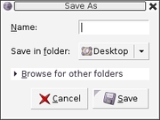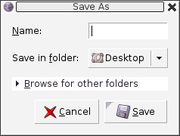
File dialog
Encyclopedia

Dialog box
In a graphical user interface of computers, a dialog box is a type of window used to enable reciprocal communication or "dialog" between a computer and its user. It may communicate information to the user, prompt the user for a response, or both...
that allows users to choose a file
Computer file
A computer file is a block of arbitrary information, or resource for storing information, which is available to a computer program and is usually based on some kind of durable storage. A file is durable in the sense that it remains available for programs to use after the current program has finished...
from the file system
File system
A file system is a means to organize data expected to be retained after a program terminates by providing procedures to store, retrieve and update data, as well as manage the available space on the device which contain it. A file system organizes data in an efficient manner and is tuned to the...
. File dialogs differ from file manager
File manager
A file manager or file browser is a computer program that provides a user interface to work with file systems. The most common operations performed on files or groups of files are: create, open, edit, view, print, play, rename, move, copy, delete, search/find, and modify file attributes, properties...
s as they are not intended for file management (although some offer simple operations such as folder
Directory (file systems)
In computing, a folder, directory, catalog, or drawer, is a virtual container originally derived from an earlier Object-oriented programming concept by the same name within a digital file system, in which groups of computer files and other folders can be kept and organized.A typical file system may...
creation), rather they are intended for the opening and saving of files. Before file dialogs, most programs requested files as a command line argument or as an exact file path. Others required users to select a file from the file manager.
Types
There are several types of file dialogs. The two most common being a two column view file dialog and a mini file browser dialog. Others include thumbnail view (for photos) and Meta-data (For music). There are several reasons for the many varieties of dialogs. First of all there is no single standard design, so a program may implement their own for any purpose. Many GUI toolkits do not provide a file dialog, so an application is forced to use its own.Two column view
The two column view is one of the primary file dialog types. It uses two columns. One for folders, and another for files. Other common features include the current folder name, a searchbox and buttons for basic file manipulation.Mini file manager
A mini file manager is often used. It represents the normal file manager, but it is restricted in its operations.Thumbnails
Usually used by image related applications, a gallery of files are shown which allow a file to be chosen graphically.Usability
File dialogs have been a subject of much usability debate. As a widget receiving constant use, ease of use is a major factor in their design. The most common reasons for file dialog usability problems include:- File system limitations,
- Wrong type of dialog for the application (e.g. no thumbnail view in a Wallpaper Selector, As in GNOMEGNOMEGNOME is a desktop environment and graphical user interface that runs on top of a computer operating system. It is composed entirely of free and open source software...
2.6), - Horizontal scrolling (As in Windows file dialogs),
- Uses non standard terminology (Commonly in ports from other operating systems)
Many application toolkits such as Motif
Motif (widget toolkit)
In computing, Motif refers to both a graphical user interface specification and the widget toolkit for building applications that follow that specification under the X Window System on Unix and other POSIX-compliant systems. It emerged in the 1980s as Unix workstations were on the rise, as a...
and GTK+
GTK+
GTK+ is a cross-platform widget toolkit for creating graphical user interfaces. It is licensed under the terms of the GNU LGPL, allowing both free and proprietary software to use it. It is one of the most popular toolkits for the X Window System, along with Qt.The name GTK+ originates from GTK;...
have been criticised for their lack of it. Early versions of Microsoft Windows also suffered from problems, mainly from the DOS legacy behind it. However, most of these are being addressed as more legacy programs are being converted to use newer, more usable file dialogs.
Powerbox
A file powerbox is a file dialog that will dynamically grant the application that opened it the right to access the file that the user chooses.This means that an application does not have to run with the user's full authority. In other words, the application does not have to have the right to access all the user's files. An important aspect of the powerbox interface is that it can look to the user just like any other insecure file dialog, but can act to protect the bulk of the user's files from potentially untrustworthy software such as Trojan horses
Trojan horse (computing)
A Trojan horse, or Trojan, is software that appears to perform a desirable function for the user prior to run or install, but steals information or harms the system. The term is derived from the Trojan Horse story in Greek mythology.-Malware:A destructive program that masquerades as a benign...
or other forms of Malware
Malware
Malware, short for malicious software, consists of programming that is designed to disrupt or deny operation, gather information that leads to loss of privacy or exploitation, or gain unauthorized access to system resources, or that otherwise exhibits abusive behavior...
.
With a powerbox system, the file dialog is implemented as a trusted part of the system. It runs in a protection domain separate from the application. The powerbox component has access to all the user's files, whereas the application does not.
Powerbox systems have been implemented in Apple
Apple
The apple is the pomaceous fruit of the apple tree, species Malus domestica in the rose family . It is one of the most widely cultivated tree fruits, and the most widely known of the many members of genus Malus that are used by humans. Apple grow on small, deciduous trees that blossom in the spring...
Mac OS X Lion
Mac OS X Lion
Mac OS X Lion is the eighth and current major release of Mac OS X, Apple's desktop and server operating system for Macintosh computers....
.

